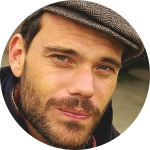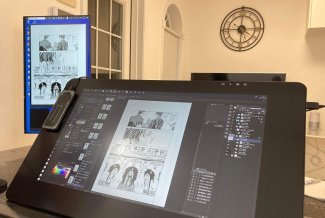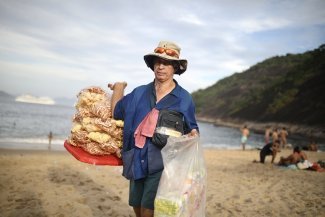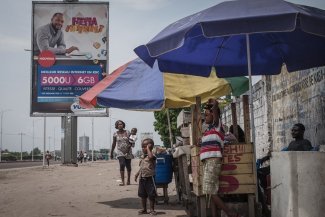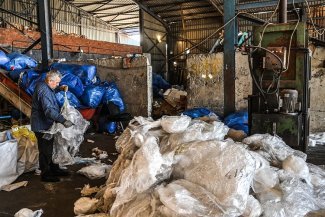In the small city of El Callao, many shops that exchange gold into cash can be found. (Image May 2018)
Under glass displays, nappies and coffee are sold as luxury items in the supermarkets of Caracas, the capital of Venezuela. Customers’ baskets are mostly empty. Some food items like cereal and tomato sauce are spread out across the shelves in an attempt to fill the gaps. In an alleyway in the city centre, a group of street children rummage through the rubbish bins of a restaurant, a sight that had all but disappeared during the presidency of Hugo Chávez (1999-2013). The effects of the economic crisis that began in 2014 can be seen throughout the country. One International Monetary Fund (IMF) official, Alejandro Werner, projects a “surge in inflation to 1,000,000 per cent by end-2018.”
Eight hundred and fifty kilometres to the south in El Callao, a small city of roughly 22,000 inhabitants in the state of Bolivar, the situation is completely different. While cash has disappeared from the rest of the country and Venezuelans pay their expenses by credit card, here, banknotes fill entire bags. The prices posted in shops are half of what they are in the capital. It’s a parallel universe, far removed from any crisis.
El Callao has been a mining town since it was founded in 1853, but today its gold mines have become magnets that attract Venezuelans faced with economic hardships and in search of income. The same is true throughout the so-called “Mining Arc” of the Orinoco River basin.
On 24 February 2016, continuing a project initiated by his predecessor, the late Hugo Chávez, Nicolás Maduro designated 12 per cent of Venezuelan territory (111,843 km²) south of the Orinoco River as a “national strategic development zone.” In this subsoil, overflowing with gold as well as coltan, diamonds, bauxite and other metals, the government sees an opportunity to compensate for the decline of its oil production, the country’s primary source of wealth.
In El Callao, however, government investment is nowhere to be seen. The mines and plantas (where the gold is extracted) belonging to national mining company Minerven are for the most part abandoned.
Some have been taken over by artisanal and small-scale mining (ASM) operations and are controlled by armed gangs. This is the case at the planta in Perù, not far from El Callao, where infrastructure is rusting and buildings have fallen into ruins.
These are symptoms of the government’s plan to turn over development of the Mining Arc to the private sector. Not long ago, it vaunted its “alliances” with 150 companies from 35 different countries. The aim of these “alliances” is to give rise to mixed enterprises, with 55 per cent of capital belonging to the state. The reality on the ground is that these investments have had a hard time coming to fruition. The crisis and insecurity in the country have discouraged many companies. Minister of Ecological Mining Development Victor Cano tacitly admitted failure in March 2018, announcing that only “three mixed enterprises” were working in the Mining Arc, and that there would ultimately be only “70 strategic alliances.” The roughly 17 tons of gold that have been handed over to the Central Bank of Venezuela (BCV) since 2016 are in fact the result of work by small-scale miners who work independently and sell their output to the government via Minerven, which has effectively become a purchasing centre.
Makeshift mining
Edward Rodriguez is one of these small-scale artisanal miners. At a molino (mill) in La Ramona, not far from El Callao, where the miners bring bags of soil from their mines to extract gold, he explains that he earned “a little more than the minimum wage” when he was an industrial engineer. “But that wasn’t enough to feed my four children. So, I quit and came here,” he explains, raising his voice to talk above the repetitive noise of stones being crushed by massive machines. He says that he sends 20 million bolivars a week to his family, 20 times the minimum wage.
“A few years ago, the mill was difficult to access. The mines were hard to see and they were surrounded by woods,” explains the young man who is in charge of the mill, which he inherited from his father, and who wishes to remain anonymous. Today, the mill is surrounded on all sides by fields of whitish sludge strewn with tarpaulins, which protect the winch-topped shafts. Veteran miners accept newcomers without animosity: “We can pull more out of the ground!” is how Eduardo Aviles puts it into perspective. Now 27, he has been digging since he was 14. “Some newcomers die,” he explains, sitting in the shade of his simple camp with only a hammock for a bed. “They don’t know how to use their picks and the mines cave in…”. Aviles, who dreams of one day opening a grocery store, climbs out of a shaft where he works in suffocating heat between eight and 17 hours a day. The “shaft” is nothing more than a simple hole, one metre in diameter and 25 metres deep. Beams to support the galleries are rare in the mine’s narrow passages.
Though the government is currently conducting a census of the mining population, it is hard to quantify the scale of the rush taking place in the region. But its effects are evident.
At the edge of the city of Guayana, 170 kilometres north of El Callao, roughly one hundred men with miner’s pans on their backs and picks in their hands wait for a car to take them to their destination. Many Venezuelans are flocking to the region to take advantage of the economic windfall by setting up small businesses.
In this collective taxi, four passengers are returning to Caracas from a stay in El Callao. The woman applying makeup used to be a music producer. The crisis resulted in the loss of all her contracts. She went to El Callao because “there’s money” there. Sitting next to her, a forty-year-old woman explains that she runs a small mobile shop where she sells sweets. She multiplies her profits by reselling the cash she earns in the capital, where it is sorely lacking.
The influx of miners can be measured in terms of accelerated deforestation. Venezuelan biologist Gustavo Montes reports that between 2001 and 2015, an average of 19,258 hectares of forestland per year disappeared in the state of Bolivar where the Mining Arc is located. In 2016 alone, more than 34,000 hectares were deforested. The government assures that the decree issued in 2016 allows for increased monitoring of mining activities – even that the mines can be made “environmentally friendly,” as Nicolas Maduro claims.
According to Aiskel Andrade, political scientist at the Andrés Bello Catholic University (UCAB) of Ciudad Guayana, this last claim amounts to cynicism on the part of the government. “The government does not have the capacity to oversee the entire area, but they have reserved all of it by decree and control it with military force and without any trade unions,” she maintains.
Satellite images taken by the University of Maryland show that deforestation continued in 2017. Located in the Orinoco Mining Arc are protected areas, which include most of the Imataca Forest Reserve and part of the El Caura Forest Reserve. It also borders the Canaima National Park, a World Heritage Site. As Gustavo Montes explains, deforestation “also disrupts the hydrological cycle. It reduces nature’s ability to retain rainwater.” Draughts are thus becoming increasingly common and can slow down operations at the Guri damn, which supplies most of Venezuela’s electricity.
Arming against the miners “with bows and arrows”
The region’s local population, particularly its indigenous peoples, see the mines as a threat to their way of life. A hundred kilometres south of El Callao, not far from Troncal 10, the road that runs toward Brazil, Coremoto Francis of the Kali’na people describes the threat from the porch of her wooden house: “There have always been mines here but now they’re not more than an hour and a half walk from here.” The spread of these mines is eating away at the fields where the villagers’ cattle graze. Francis explains that it is increasingly difficult to live off the land. Last year, the members of the community donned their traditional clothing, armed themselves “with bows and arrows,” and went to confront the miners. “Someone had warned them ahead of time and they were gone. Since then they’ve come back,” she says.
Indigenous peoples do not speak with a single voice. Faced with the denunciations of mining opponents and indigenous advocacy groups who claim that the mining projects are imposed on communities without prior consultation (as required by the Indigenous Peoples and Communities Organic Act [LOPCI] and International Labour Organization [ILO] Convention 169), the government has responded by highlighting the support of certain indigenous leaders.
A little further down Troncal 10, Francisco Dion de Souza, also indigenous and the capitán of San Flaviano, a community of about 300 inhabitants, doesn’t blame some of his neighbours who have been won over by the lure of gold.
“The mine brings great misfortune, but it’s also the only source of income here,” he explains while selling fruit on the side of the road. The “misfortune” to which Francisco Dion De Souza refers is the proliferation of disease. Deforestation and the massive amount of water used have led to a proliferation of mosquitos that spread malaria, a disease that, according to the capitán, affects “80 per cent of the community.”
The subsoil and waterways have also been polluted by the massive amounts of mercury used in the mills to extract gold from soil. The mills of La Ramona use this process despite a ban by presidential decree. But since the government doesn’t have the means to enforce the law and continues to buy gold with little concern, miners continue to use the process.
After the soil and rock are crushed, a toxic muddy liquid is released through a pipe into a pond, which still has a gold content of over 60 per cent. This mercury threatens the country’s largest freshwater reserves, such as the Caroni Basin. “Our community regularly loses cows who drink contaminated water,” explains Coremoto Francis. According to a study by the Central University of Venezuela (UCV) published in 2010, 74 per cent of schools inspected in El Callao had above-average levels of mercury. Since then, the number of illegal mining operations and the amount of mercury used have continued to increase.
The government wants to change this method of treatment and replace mercury with cyanide, which is considered to be less polluting. After the leaching process (solvent extraction), the chemical dissolution used to extract gold, the toxic sludge is then stored in large basins. Geographer Florencia Cordero of Ciudad Guayana University agrees that that cyanide is less harmful than mercury, but adds that “the dykes can break if they are not sufficiently monitored.” This scenario has occurred several times, including in Argentina in 2015.
To make this change, the government has to persuade miners working in illegal operations. It hopes to achieve this by legalising their activity and buying gold at favourable black market rates (several exchange rates coexist in Venezuela). The young manager of the mine in La Ramona already sells his pond tailings to Minerven but does not intended to change his treatment methods. The use of cyanide requires major investments and is much larger in scale. For him, switching to cyanide would mean the end of his molino.
The violent reign of the pranatos
The government is not alone in seeking economic benefit from the gold mined by artisanal miners: armed gangs also control vast territories. They are known as pranatos, a term that generally refers to criminal organisations based in Venezuela’s prisons. Miners operating in their territories must pay them part of their output as “rent” in order to ensure their “protection.”
These pranatos engage in violent turf wars, when not fighting the army itself. According to the watchdog group Observatorio Venezolana de Violencia (OVV), El Callao holds the national record for violent deaths with 816 victims for every 100,000 people in 2017.
At the mention of the pranatos, the miners become tight-lipped. A 44-year-old miner, his face already wrinkled, says under his breath: “they could kill me for talking to you.”
After the massacre near Tumeremo on 4 March 2016, which claimed the lives of roughly twenty miners, Nicolás Maduro declared the Orinoco Mining Arc a “special military zone,” deploying “more than 1,000 agents of the Bolivarian National Armed Forces.” The miners, however, don’t trust the army. They often refer to the “impotence” of the military, which negotiates with the gangs when “they aren’t even asking for anything.”
A few months before being interviewed by Equal Times, 26-year-old José Gregario witnessed a bloody confrontation. Since then, he has been working in a mine less rich in gold but further away from the violence. While watching his friend descend into the mineshaft, he explains that he is aware of the danger of mercury, knocks on wood in order to avoid catching malaria and admits that he is afraid of criminals. But for this former business student, who doesn’t plan on being a “miner all his life,” quitting is not an option: “I can’t earn this much anywhere else.”



